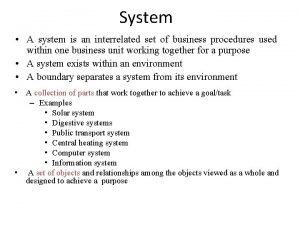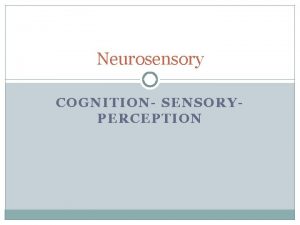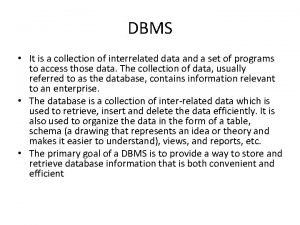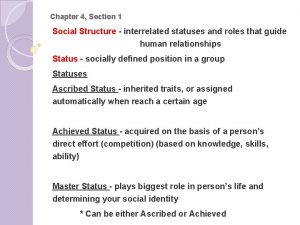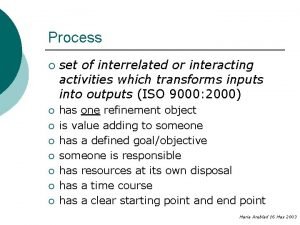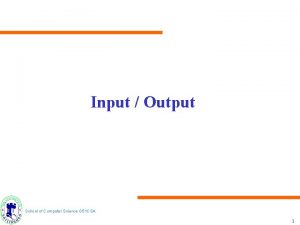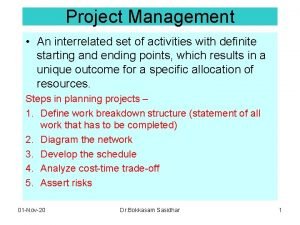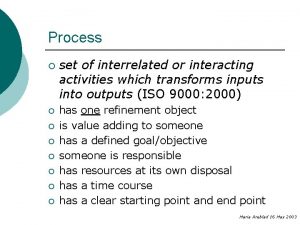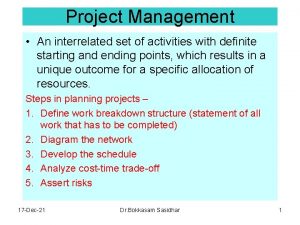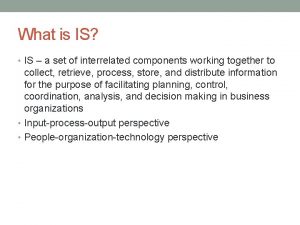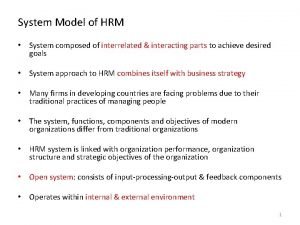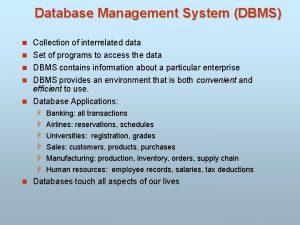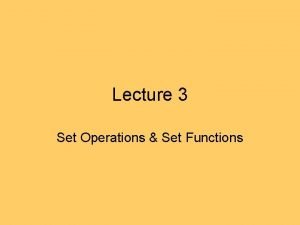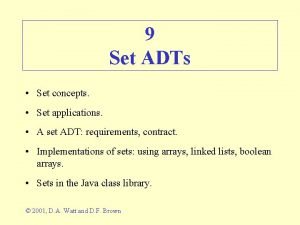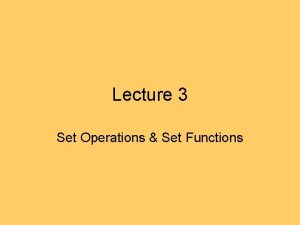System A system is an interrelated set of
























- Slides: 24

System • A system is an interrelated set of business procedures used within one business unit working together for a purpose • A system exists within an environment • A boundary separates a system from its environment • A collection of parts that work together to achieve a goal/task – Examples • Solar system • Digestive systems • Public transport system • Central heating system • Computer system • Information system • A set of objects and relationships among the objects viewed as a whole and designed to achieve a purpose




Characteristics of a System • • • Components Interrelated Components Boundary Purpose Environment Interfaces Constraints Input Output

Systems Can Be Composed of Subsystems System Subsys A Subsys B Subsys A-1 Subsys. B-1 Subsys A-2 Subsys. B-2 Subsys A-3 Elemental part B 1 Elemental Part C

What is subsystem? • A subsystem is simply a system within a system. – Automobile is a system composed of subsystems: • • • Engine system Body system Frame system – Each of these subsystem is composed of sub-sub -systems. • Engine system: carburetor system, generator system, fuel system, and so son


Important System Concepts • Decomposition – The process of breaking down a system into smaller components – Allows the systems analyst to: • Break a system into small, manageable subsystems • Focus on one area at a time • Concentrate on component pertinent to one group of users • Build different components at independent times

Important System Concepts • Modularity – Process of dividing a system into modules of a relatively uniform size – Modules simplify system design • Coupling – Subsystems that are dependent upon each other are coupled • Cohesion – Extent to which a subsystem performs a single function

Systems Analysts • Systems analysts are the key individuals in the systems development process. • A systems analyst studies the problems and needs of an organization to determine how people, data, processes, communications, and information technology can best accomplish improvements for the business. • The organizational role most responsible for the analysis and design of information systems.

Skills Required by Systems Analysts – Working knowledge of information technology – Computer programming experience and expertise – General business knowledge – Problem-solving skills – Interpersonal communication skills – Interpersonal relations skills – Flexibility and adaptability – Character and ethics – Systems analysis and design skills

• Systems Analysis: understanding and specifying in detail what an information system should do • System Design: specifying in detail how the parts of an information system should be implemented • Definition of SAD: – The complex organizational process whereby computerbased information systems are developed and maintained.

System development methodology • A standard process followed in an organization to conduct all the steps necessary to: • • Analyze Design Implement Maintain information system

Systems Development Life Cycle (SDLC) • It is a common methodology for systems often follows for system development in many organization, featuring several phases that mark the progress of the systems analysis and design effort. • SDLC phases: – – 1 -Project identification and selection 2 -Project initiation and planning 3 -Analysis 4 -Design • 4. 1 Logical design • 4. 2 Physical design – 5 -Implementation – 6 -Maintenance 1. 15

1 -Project identification and selection phase – The first phase of the SDLC in which an organization total information systems needs are identified analyzed, prioritized and arranged. • Identifying Potential development projects • Classifying and ranking projects • Selecting projects for development

2 -Project initiation and planning phase – The second phase of the SDLC in which a potential IS project is explained an argument for continuing with the project is presented. A detailed plan is also developed for conducting the remaining phases of the SDLC for the propose system. Output are: • Detailed step – work plan - high level system requirement –assignment of team members

3 - Analyzing systems • The primary objective of the analysis phase is to understand document the business needs and the processing requirements of the new system. There are six primary activities in this phase: • Gather information. • Define system requirements. • Build prototypes for discovery of requirements. • Prioritize requirements. • Generate and evaluate alternatives. • Review recommendations with management

4 -Design phase – The forth phase of the SDLC in which the description of the recommended solution is converted into logical and then physical system specification. • Logical design: – The part of the design phase of the SDLC in which all functional feature of the system chosen for development in analysis are described independently of any computer platform. • Physical design: – The part of the design phase of the SDLC in which the logical specification of the system from logical design are transformed into technology specific details from which all programming and system construction can be accomplished.

4. 1 Logical design output – Functional, – Detailed specification of all system elements • Input • Output • Process

4. 2 Physical design output – Technical – Detailed specification of all system elements • • • programs, files, network, system software etc – Acquisition plan of a new technology

Cont. 4 - Designing the recommended system • Its primary objective is to convert the description of the recommended alternative solution into system specification. – High-level design consists of developing an architectural structure for software programs, databases, the user interface, and the operating environment. – Low-level design entails developing the detailed algorithms and data structures that are required for program development. • Seven major activities must be done during design: • • Design and integrate the network. Design the application architecture. Design the user interfaces. Design the system interfaces. Design and integrate the databases. Prototype for design details. Design and integrate the system controls

5 - Implementation – The fifth phase of the SDLC in which the information system is • • Coded, Tested, Installed, and Supported in the organization. – Outputs: • Code, documentation, training procedures and support capabilities

6 -Maintances – The final phase of the SDLC in which the information system is systematically repaired and improved – Output are: • New versions of releases of software with associated updates to documentation, training, and support
 System is a set of interrelated subsystems.
System is a set of interrelated subsystems. System is a set of interrelated subsystems
System is a set of interrelated subsystems Total set awareness set consideration set
Total set awareness set consideration set Training set validation set test set
Training set validation set test set A set of systematically interrelated concepts
A set of systematically interrelated concepts A set of interrelated concepts definitions and propositions
A set of interrelated concepts definitions and propositions Bounded set vs centered set
Bounded set vs centered set Fucntions
Fucntions Crisp set vs fuzzy set
Crisp set vs fuzzy set Crisp set vs fuzzy set
Crisp set vs fuzzy set What is the overlap of data set 1 and data set 2?
What is the overlap of data set 1 and data set 2? Surjective vs injective
Surjective vs injective Interrelated concepts nursing
Interrelated concepts nursing A dbms is a collection of interrelated data and
A dbms is a collection of interrelated data and Salmon white’s construct for public health nursing
Salmon white’s construct for public health nursing How are structures interrelated to each other
How are structures interrelated to each other The interrelated nature of hospitality and tourism
The interrelated nature of hospitality and tourism Interrelated special education
Interrelated special education Introduction to ecommerce
Introduction to ecommerce Interrelated processes
Interrelated processes The interrelated nature of hospitality and tourism
The interrelated nature of hospitality and tourism A set of i/o modules is a key element of a computer system
A set of i/o modules is a key element of a computer system Alter system set optimizer_features_enable
Alter system set optimizer_features_enable Closed system earth
Closed system earth Site:slidetodoc.com
Site:slidetodoc.com

